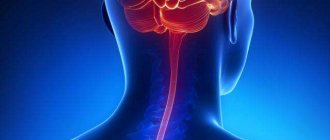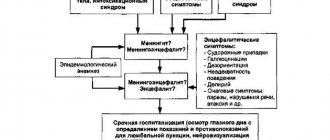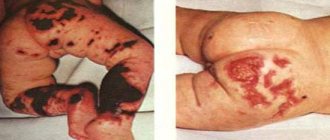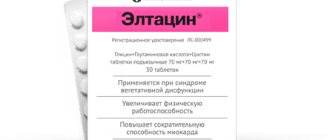Meningitis is a dangerous infectious disease that affects the meninges. It can be bacterial, fungal or viral in nature. Viral meningitis is also called serous meningitis and causes inflammation of the brain and spinal cord. Serous meningitis occurs most often in the summer, which is associated with the seasonality of some viral diseases. However, the risk of infection at other times of the year cannot be excluded. When the first signs of meningitis appear, it is important to consult a doctor as soon as possible.
At the Yusupov Hospital, the patient will be provided with all the necessary medical care: they will conduct an examination and prescribe adequate treatment. Experienced doctors at the Yusupov Hospital can quickly determine the type of disease and, without wasting time, begin therapy, which will reduce the risk of complications.
Causes
More than 60% of cases of serous meningitis are caused by enteroviruses, which are the main causative agents of viral meningitis. Infectious agents that cause inflammation of the meninges include:
- enteroviruses (70-80% of cases);
- arboviruses;
- Coxsackie viruses type A and B;
- parotitis;
- togaviruses;
- HSV type 2;
- cytomegalovirus;
- adenoviruses
The incidence of viral meningitis increases sharply in the summer. Rotavirus meningitis develops extremely rarely.
What is viral meningitis?
Pathology develops as a result of viruses entering the body through airborne droplets.
In addition, it can be caused by brain injury, the growth of tumors, or the use of certain medications.
In this case, the protective membranes of the brain come under attack.
This disease does not occur very often, but it has very clear symptoms, a short incubation period and can leave serious consequences.
The pathogen can enter the body from the outside or exist in it for a long time without showing itself in any way.
Serous meningitis of a viral nature most often affects children whose immunity is not yet strong enough.
Although it can also occur in adults, who have significantly reduced body defenses. A characteristic feature of the disease is that during inflammation, a serous effusion appears, penetrating through the meninges and causing them to thicken.
Although the viral type of disease is milder than the bacterial one.
In the video, folk doctors from the program “Live Healthy!” will tell you in detail about the disease:
Symptoms
The incubation period for viral meningitis usually lasts 2-4 days.
The disease begins acutely, with high fever and general intoxication. In patients with high body temperature, malaise increases, muscle and joint pain, nausea and vomiting, abdominal pain, and diarrhea appear. Slight drowsiness and stupor are often associated. More severe signs of meningitis (impaired consciousness, stupor and coma) are not typical for inflammation of the meninges caused by viruses and require a more in-depth examination of the patient. From the first or second day of the disease, doctors determine a clearly defined meningeal syndrome:
- severe headache;
- repeated vomiting;
- lethargy and drowsiness, sometimes agitation and anxiety.
Patients may complain of cough, runny nose, sore throat and abdominal pain.
Often, patients with viral meningitis develop skin hyperesthesia (increased sensitivity to various irritants). On examination, neck rigidity and signs of severe hypertensive cerebrospinal fluid syndrome are revealed. During a lumbar puncture, clear, colorless cerebrospinal fluid flows out under pressure. An increased content of lymphocytes is determined in the cerebrospinal fluid, while the levels of protein, glucose and chlorides are within normal limits. After 3-5 days, body temperature normalizes. Sometimes a second wave of fever appears. In patients with viral meningitis, the following meningeal signs are determined:
- Kernig's symptom - the patient cannot straighten the leg bent at a right angle;
- Brudzinski's symptom: lower (when trying to straighten one bent leg, a reflex flexion of the second leg occurs), and upper - when bending the head, involuntary flexion of the lower limb occurs;
- Babinski's symptom - dorsiflexion of the first toe occurs with streak irritation of the plantar surface of the foot.
In most adults, viral meningitis occurs without complications. Some recovering patients complain of headaches for several weeks or months. They have mild intellectual impairment, asthenia or impaired coordination of movements. The prognosis for newborns and infants is not clear. They may have persistent complications in the form of intellectual impairment, learning difficulties, and hearing loss.
Vaccination against meningococcus and pneumococcus
Currently, the development of meningococcal and pneumococcal meningitis can be avoided through routine vaccination. Vaccinal prophylaxis against pneumococcus was included in the National Vaccination Calendar in 2014 and is carried out in the first year of life. The first vaccination is carried out for the baby at 2-3 months, in the absence of indications for a medical exemption and with the consent of the parent. Two repeated injections are given subsequently at an interval of 1.5 months. Revaccination is carried out at one and a half years. If there are indications for medical exemptions, the timing of prophylaxis may be shifted. In clinics, vaccination against pneumococcus is carried out using the drug “Prevenar”.
Vaccination against meningococcus exists, but is not included in the National Vaccination Calendar as a mandatory recommendation. It is recommended to perform it in patients with reduced immunity. In Russia, it is possible to use vaccines against meningococcus:
- Russian production - from serotypes A and C, performed from 1.5 years. Revaccination at three years;
- Belgian production - "Mencevax", from serotypes A, C, W, Y. For children over 2 years old and adults;
- French – “Meningo A+C”, used from 1.5 years;
- American - "Menactra", from A, C, Y, W-135, from 1.5 years to 55 years.
Vaccination is possible only after examination by a doctor against the background of the absence of acute infectious diseases, fever, or exacerbations of chronic diseases. After vaccination, there may be an increase in temperature for several days, redness at the injection site, and slight malaise.
Diagnostics
The diagnosis of viral meningitis can be reliably established or refuted by examining the cerebrospinal fluid.
A large number of lymphocytes and a slightly elevated protein level with normal glucose concentrations are detected in the cerebrospinal fluid. An indirect sign of the viral nature of meningitis is the absence of the pathogen in cerebrospinal fluid smears of any type of color. In the first 48 hours of illness, especially in some enterovirus infections and meningitis caused by eastern equine encephalomyelitis virus or ECHO virus 9, cytosis may be predominantly neutrophilic. In this case, the spin fluid analysis is repeated after 8-12 hours and it is monitored whether a lymphocytic shift has appeared. If neutrophils are present in the cerebrospinal fluid, an additional examination is performed to exclude bacterial meningitis or the presence of a focus of infection near the meninges.
Cytosis in viral meningitis does not exceed 1000 in one microliter of cerebrospinal fluid. Glucose levels are normal in most cases, but may be decreased in meningitis caused by the mumps virus, inflammation of the meninges caused by ECHO viruses and other enteroviruses, herpes simplex virus type 2, Varicella-zoster virus, or lymphocytic choriomeningitis. More often, lymphocytosis with low glucose levels is evidence of fungal, tuberculous or listeria meningitis or a non-infectious disease (sarcoid meningitis and diffuse tumor infiltration of the meninges).
Isolating the virus from cerebrospinal fluid is technically difficult. Adenoviruses and enteroviruses can be detected in feces, arboviruses in blood, mumps virus and cytomegalovirus in urine. Enteroviruses, mumps virus and adenoviruses are detected in nasopharyngeal swabs.
An important method for diagnosing viral meningitis is the detection of viral DNA or RNA using polymerase chain reaction (PCR). This method allows the detection of herpes simplex virus DNA in the cerebrospinal fluid of patients with Mollaret meningitis or herpetic encephalitis, even with negative culture results. PCR is widely used to detect Varicella Zoster virus, cytomegalovirus, and Epstein-Barr virus. This is the method of choice for detecting picornaviruses (poliomyelitis, Coxsackie, ECHO viruses) in the cerebrospinal fluid of patients suffering from meningitis.
Diagnosis of viral meningitis is carried out using electrophoresis of cerebrospinal fluid in agarose gel or isoelectric focusing of gamma globulins. These methods make it possible to identify oligoclonal immunoglobulins in meningitis caused by:
- human immunodeficiency virus;
- Human T-lymphotropic virus type 1;
- Varicella Zoster virus;
- mumps virus.
An increase in immunoglobulin titer is often accompanied by the appearance of antibodies to viral proteins.
Identification of oligoclonal immunoglobulins helps to carry out differential diagnosis, since they are absent in viral meningitis caused by enteroviruses, arboviruses and herpes simplex virus. Each patient with suspected viral meningitis at the Yusupov Hospital undergoes:
- general blood analysis;
- biochemical studies of liver function;
- determination of hematocrit, erythrocyte sedimentation rate, nitrogen and urea levels in the blood;
- determination of electrolytes and blood plasma glucose, creatinine, amylase and lipase.
Changes in certain indicators make it possible to clarify the nature of the disease.
Question answer. Issue 13 “Meningitis”
After the video about meningitis, where Dr. Komarovsky talks about the main features of this terrible disease, many questions were received from viewers. This recording will provide answers to the most common of them: what signs can be used to suspect meningitis, how to protect yourself from the disease, what and who should be vaccinated with, are antibiotics and other medications effective for the prevention of meningitis during an outbreak, is a spinal puncture dangerous and what to do if there was contact with a patient with meningitis.
Questions that Dr. Komarovsky answers in this issue:
- Main symptoms of meningitis
- Do meningitis always cause fever and rash?
- Is it possible to get meningitis again?
- Is there always stiffness in the neck muscles with meningitis?
- What is meningism
- Do meningitis carriers have immunity or do they also get sick?
- If the rash does not go away with pressure, is it meningitis or not?
- What foods are best not to eat if you have meningitis?
- Is meningitis a seasonal disease or not?
- What contributes to the spread of meningitis?
- Is the causative agent of meningitis sensitive to sunlight?
- When will meningitis subside?
- Is it possible to get meningitis through water?
- Will you get meningitis if you have a headache?
- Is it possible to get meningitis without contact with a sick person?
- Who is at risk for meningitis?
- Is there a genetic predisposition to meningitis?
- Until what age do people get meningitis?
- Chronic tonsillitis contributes to meningitis or not
- Can carriers of meningitis infect other people?
- How to protect yourself from meningitis in public places
- What to do to prevent meningitis
- Will moving to another city during an outbreak protect you from meningitis?
- Do I need to take antibiotics to prevent meningitis?
- Will gargling really prevent meningitis?
- Can a child gargle on his own?
- Is it possible to go to kindergarten during an outbreak of meningitis?
- It is true that it takes 3 hours of communication with the carrier to become infected.
- Are furacillin, levomekol and erythromycin used to prevent meningitis?
- Is a humidifier effective in preventing meningitis?
- Will air disinfection devices protect against infections at home?
- Do sprays for the prevention of acute respiratory infections help prevent meningitis?
- Why are antiviral drugs recommended for meningitis?
- What medications should you have in case of meningitis?
- What to do if you experience symptoms of meningitis on the road
- How to avoid getting meningitis if the kindergarten is not ventilated and there is no exercise
- Does ribomunil help prevent meningitis?
- Will oxolinic ointment in the nostrils protect against meningitis infection?
- Which meningitis vaccination is best to get before traveling to Kazakhstan?
- Should I get vaccinated against meningitis every year?
- Is vaccination effective if an epidemic is already underway?
- Why vaccination at all if the vaccinated child also gets sick?
- Who should be vaccinated against meningitis?
- What to do if a meningitis vaccine is not available
- Do vaccinated children get sick less than unvaccinated children?
- Is it worth getting vaccinated if infections are constantly mutating?
- What tests do you need to take to find out whether you are a carrier of meningococcus or not?
- If there is meningococcus in the body, does it need to be treated?
- Is cerebrospinal fluid puncture alone a definitive diagnosis of meningitis?
- Is it dangerous to perform a cerebrospinal fluid puncture?
- What should doctors do if they suspect meningitis?
- If we were wearing masks next to someone with meningitis for several hours, then are we contacts or not?
- What to do if you have been in contact with someone with meningitis
- Does Polysorb help prevent meningitis?
- Does groprinosin help prevent meningitis?
- How to act and how long to monitor a pregnant woman if there has been contact with a patient with meningitis
Materials referenced by Dr. Komarovsky in this issue:
- Meningitis outbreak! Dr. Komarovsky answers questions
- Meningococcal infection and vaccination against it
published 20/09/2018 10:00 updated 04/10/2018 — Questions and Answers
Treatment
At the Yusupov Hospital, doctors provide treatment for viral meningitis, aimed at preventing or limiting the formation of irreversible damage to the brain. To destroy pathogens of viral infection, patients are prescribed the following medications:
- recombinant α-interferon;
- inducers of endogenous interferon (neovir, cycloferon);
- RNase;
- intravenous immunoglobulins (intraglobin F).
Antiviral drugs are prescribed from 2 to 5 days of illness or in severe condition of a patient with viral meningitis.
In severe cases of the disease, glucocorticoids are used during the first 2-3 days of the disease: dexamethasone or prednisolone. If the patient develops complications, antibacterial drugs are prescribed. For serous meningitis caused by a virus or Epstein-Barr, acyclovir is prescribed. For immunocompromised patients, immunoglobulin is administered intravenously. To reduce intracranial pressure, furosemide, Lasix or acetazolamide are prescribed. With severe cerebral edema, treatment with mannitol is started. Detoxification therapy is carried out with glucose solution, rheopolyglucin, albumin, plasma. Crystalloid and colloid solutions are administered intravenously.
When the body temperature is above 38 degrees, antipyretics are used - paracetamol, ibuprofen. All patients with serous meningitis at the Yusupov Hospital are prescribed drugs that improve the metabolism of cells of the central nervous system: piracetam, nootropil, picamilon. To reduce the energy deficit of the brain and improve tissue metabolism in viral meningitis, ascorbic acid and riboxin are prescribed. In severe cases of the disease, antioxidants are prescribed - cytomol, cytochrome. From the first day of therapy, all patients with viral meningitis are prescribed drugs that improve cerebral circulation (Cavinton, dipyridamole).
Meningitis: incubation period
It is completely impossible to determine the total duration of the incubation period for menigitis. It is completely different and directly depends on the type of infection and the type of pathogen:
- When infected with serous meningitis, it lasts about a week;
- With purulent meningitis it is reduced to 4 days;
- With viral meningitis, the duration is ambiguous - 2-10 days, but most often its duration does not exceed 4 days.
Only at the end of the incubation period do the main signs and symptoms of the disease begin to appear. During this period, a person is dangerous to others, as he is a direct carrier of dangerous bacteria. After 10-12 days, when the patient begins to show the first obvious signs of the disease, it ceases to be contagious.
Regardless of the type of disease and its incubation period, when helping a patient, others and health workers must strictly adhere to the general rules of hygiene:
- Wash your hands regularly and thoroughly
- Wash cutlery properly
- Clean toys for children regularly
Prevention
To avoid getting viral meningitis, you should not swallow water while swimming in open water.
You should observe the rules of personal hygiene and thoroughly wash vegetables and fruits before eating. To prevent influenza, vaccination is carried out. If you have signs of viral meningitis, call the Yusupov Hospital. Doctors examine patients using equipment from leading European and American companies. To treat patients, neurologists use effective antiviral drugs that have a minimal range of side effects.
Make an appointment
Symptoms and consequences of meningitis in infants
Among the most common complications of this disease:
- severe and regular headaches;
- pronounced delays in physical and emotional development;
- mental development disorders;
- frequent seizures.
The most dangerous complications include epilepsy, loss of vision and hearing, kidney failure and cerebral edema, which can be fatal. Children who have had this disease are subject to long-term observation by a pediatrician, infectious disease specialist and neurologist with regular instrumental studies.iv
Causes and consequences of meningitis in newborns
The following categories of children are most susceptible to the disease:
- premature babies;
- born as a result of an abnormal pregnancy or pregnancy with complications, in the presence of birth injuries, open or closed traumatic injuries to the brain and spinal cord;
- those who fell ill in infancy with purulent inflammatory diseases (for example, endocarditis, tonsillitis, osteomyelitis and some others);
- children suffering from various disorders of the nervous system.
Routes of transmission of the infectious agent:
- contact and household;
- fecal-oral (with food, water);
- airborne (from sick people and carriers of infection);
- transmissible (from the bites of blood-sucking insects);
- hematogenous, lymphogenous (with the flow of blood and/or lymph from the affected organs);
- segmental-vascular (through regional vessels from the primary source of infection located nearby, bypassing the general bloodstream);
- perineural (through the tissues surrounding the nerves);
- transplacental (from a pregnant woman to the fetus).
According to the World Health Organization, about 1 million cases of meningitis are registered annually in the world, of which approximately 200 thousand cases are fatal. The risk of mortality also depends on the age of the children: the younger the child, the higher the likelihood of a tragic outcome. The outcome of the disease is determined mainly by the attentiveness of parents, doctors and the timely initiation of adequate therapy. Doctors say that it is not so much the inflammation of the meninges itself that is dangerous (which is what meningitis is), but the catastrophic complications and consequences that it can provoke in the absence of proper treatment.
The predisposition to this disease in children in the first years of life is explained by the immaturity of the immune system and increased permeability of the blood-brain barrier. Not all parents know that the background for the development of the disease can be malnutrition - malnutrition of the baby, which is accompanied by insufficient weight gain of the child in relation to his height and age. Health problems can also be caused by errors in caring for a newborn, systematic hypothermia, stress, and in some cases even a change in climatic conditions.
The best way to protect your child from this dangerous disease is prevention. Today, vaccination against this disease is carried out by both public and private medical institutions.










